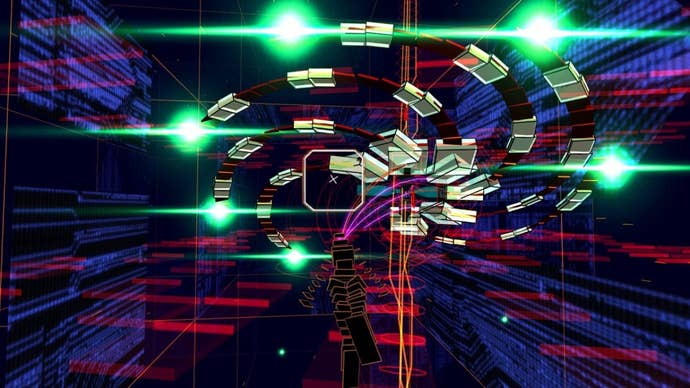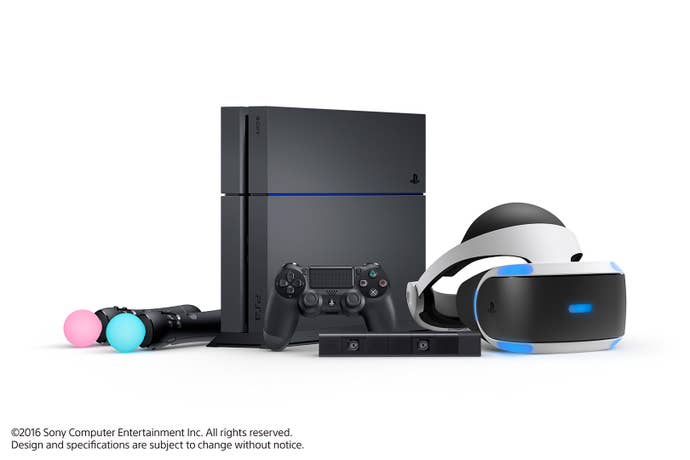The Hype Dissected: What VR Really Means For Gaming
COVER STORY: What drives the hype behind VR? We talked to people at every level of the industry to find out.
This article first appeared on USgamer, a partner publication of VG247. Some content, such as this article, has been migrated to VG247 for posterity after USgamer's closure - but it has not been edited or further vetted by the VG247 team.

Looking ahead, it's tough to imagine what fully-formed VR games will look like, mostly because they haven't really appeared yet. "VR is a new medium and just like any platform people are still trying to figure out what they can do with it." Dennis Ramirez told me over email when I asked if gaming was a good fit for the medium. Ramirez is the technical director at USC's Interactive Media and Games Division, and has lately been experimenting with designing VR apps. "Some of the best VR applications out there really embrace the current limitations of the systems and try to integrate it. Cockpit games like School Aquatic and VR racing games really take into consideration how the player is gonna be sitting, and that they won't need to many other peripherals to play."
"In those games, being able to move your head around makes sense and adds to the experience. But there are also other applications that don’t really make sense in VR, like a Twitter app. Just having text float around isn't adding to the experience of reading tweets, and is more difficult to interact with. I would much rather use a 2D Twitter app that really adds to my experience of writing and posting than a VR Twitter app that makes those things difficult. As developers, we need to consider if it makes sense to port apps like that to VR. Don't get me wrong, I'm glad they're exploring it, and if they create a way to interact with Twitter that requires VR I'd be really impressed, but the prototype I tested just felt like it was an attempt to be first to market."
Tetsuya Mizuguchi also cautions against approaching VR as a traditional gaming experience. He likens the platform to The Shawshank Redemption - the classic prison break film starring Morgan Freeman and Tim Robbins, which offers the creative and inventive Mizuguchi a new canvas. "In the end, the product is a game, but I have to think about it as, I’m creating a brand-new experience for the player, the user, the consumer, and it has to really influence and affect your feelings. It has to go straight to your heart somehow, and give you a feeling."
Rez has already proven a natural fit for VR. It works because it takes the original's propulsive beat and surrounds you with it, totally immersing you in its world of sight and sound. Rez and Audioshield - the new game by the creator of Audiosurf - are interesting because they provide a new means for visualizing music, allowing audiophiles to become totally engaged with their favorite song.
While Mizuguchi and other developers tinker with existing gameplay possibilities, though, McCauley is thinking bigger. "[The MEMS Tracking System] is cheap enough to put ten of these, twenty of these in a volume, like an arcade, and run around inside the arcade with other players and play against them, as an avatar. That's what I want to do. It's not practical to have... no one has a home that big, right. But you can have one or two of these to have a smaller experience. I think the limitation with Vive is the small play volume. What are you going to do with eight feet by eight feet?"

The Headsets: PlayStation VR
$399, October 2016
Sony's PlayStation VR will be the sole console-based headset when it launches in the fall. Using the PlayStation 4 as a base, it uses the PlayStation Camera as a tracking system while outputting visuals roughly on par with the Rift. The PSVR benefits heavily from the fixed nature of the PS4, removing the need for a powerful gaming PC, and it is the cheapest of the three major headsets. However, the $399 bundle will not include a PlayStation Camera.
This is what developers like McCauley mean when they talk about VR becoming a holodeck. With the right headset and tracking systems, motion sickness and weight will become non-issues as you navigate a real maze with a prop weapon that can become anything you want in the virtual space. Think of the possibilities of, say, next-generation laser tag, or a dueling arena where people can have actual lightsaber battles. Home headsets are bound to be popular with enthusiasts, but these sorts of arcades may ultimately be what sells mainstream audiences on VR.
Back to the present
This is all still on the drawing board, though. VR in 2016 is still in its earliest, most awkward stages. Nevertheless, it's already creating significant waves throughout the industry.
Sony is treating VR in the same way that they previously treated motion controls - as a mid-generation console refresh. The PlayStation 4's large install base - up to 36 million as of March 2016 - means that even a fraction of established users buying a PlayStation VR willl add up to millions of units sold. The advent of the PSVR has also reportedly pushed Sony to develop a PlayStation 4.5 - mid-generation console update that will support 4K and more powerful VR hardware.
But while these developments have generated plenty of hype, some analysts are being cautious. Technology research firm SuperData recently trimmed their VR revenue estimates to $3.6 billion - still bullish, but much less than the 5.1 billion they previously projected. Dutch research firm Newzoo is still collecting their own data, but they are being similarly circumspect about their expectations for VR in 2016.
"The VR space consists of so many elements outside of revenues generated by game software such as the hardware itself, video, theme park type revenues, investments by VR OEMs that we are taking our time to scope this. Of course VR and especially AR will have a huge impact on digital content and entertainment in the long-term as, in a couple generations from now, nobody will interact with a screen anymore." Newzoo CEO Peter Warman told me over email. "This is the driver for the global companies to invest. They cannot afford to miss this opportunity and need to build up a patent position. For the shorter term, we believe the biggest opportunity is in video such as a virtual trip to the north pole, spending a day with LeBron James and attending a sports or music event. For games, we do not anticipate a major new revenue stream for the coming year. Revenues will mainly cannibalize current spending on console / TV gaming."

Everything Else: Gear VR, Google Cardboard, and HoloLens
While Oculus, Valve, and Sony target the high-end of the VR experience, Samsung and Google are targeting the low-end with the Gear VR and Cardboard respectively. The latter is literally made of cardboard, but it offers a passable VR experience for as little as $10. The Gear VR is considerably pricier at $99, but it's much more capable, able to run a wide range of VR apps including the popular Keep Talking and Nobody Explodes. As for the HoloLens, Microsoft is targeting augmented reality instead of virtual reality, with some interesting results. Microsoft recently sent a version to developers and enterprise partners.Much has been made about VR's high price point - between $400 and $800 for the headsets alone - which most likely limits its appeal to earliest of adopters. But in the short-term, Ramirez believes that mobile-based headsets like the Gear VR and Google Cardboard can provide low cost entry points for curious consumers. "Lots of people have been talking about how VR’s price point is going to hurt it’s adoption, but if anyone can use their phone to run simple VR apps that’s pretty cool. Only requiring a smartphone decreases the threshold to adoption and might make people consider getting better hardware. A low threshold also lets more people do VR research which will help the field in the long run. For example, Purdue recently figured out that just adding a virtual nose reduces motion sickness. That makes sense, but discoveries like that can’t happen without accessible tech to experiment with. We’re also just scratching the surface of how we interact with others in VR. We convey a lot of information through head and body movement, and the ability to use that in games, or telepresence apps is really exciting. The other day I tried out a Virtual session of [Dungeons & Dragons] where our avatars had head tracking and 3D sound. It wasn’t perfect, but it did feel closer to playing a pen and paper RPG with friends, except some of them were halfway around the world."
While Ramirez touts the accessibility of low-cost options like Google Cardboard, though, McCauley is actually happy about the high price point of headsets like the Rift. "For Oculus, I think it's a really good price. I'll be honest with you, I think they're selling that thing at a really good price point. It's expensive to make it, and you certainly don't want to give it away. When I got the pricing structure from CES, I sent a text and I said, 'You guys have done a wonderful job on it. The pricing is perfect.' It is. The problem is that if you make it too cheap and sell it at low margin, you risk saturating the market and people putting this thing into computers which won't run it. You want to keep the price point high so you're going to sell it to the enthusiast end of things. This is my call. People that buy it already have a machine that can run it. You don't want to sell it to clowns that are going to plug it into a $400 Lenovo laptop and think they're going to get good performance out of it. They're not going to. So I thought the pricing was perfect."
For now, VR remains very much in the realm of the enthusiasts, and arguments that it will prove as revolutionary as smartphones may well prove overblown. Nevertheless, the technology is compelling; and when it works within a gaming context, the experience can be extraordinary. It's a long way from the Kinect, which was ultimately too limited to support any meaningful advancement. Awkward as it is now, VR has the potential to be a very powerful tool in the right hands.
"What form will [VR] take? If Oculus or Vive or Sony has a bad rollout on the consumer version, it's not going to stop it. They're just going to have a bad rollout, and they're going to have to sit down and reformulate and try again until they run out of money. And I don't think that Facebook is going to run out of money, and I don't think that Valve is going to run out of money." McCauley says. "So if the initial experience is not good, the other experiences that come out of it will be better and better. Remember how bad cellular phones were when they first came out? I mean, flip phones, they sucked. Actually, they didn't suck, they were good phones, but they didn't have much you could do with them besides make phone calls. And look at where they are now - you're getting rid of your desktop because you have a phone."








